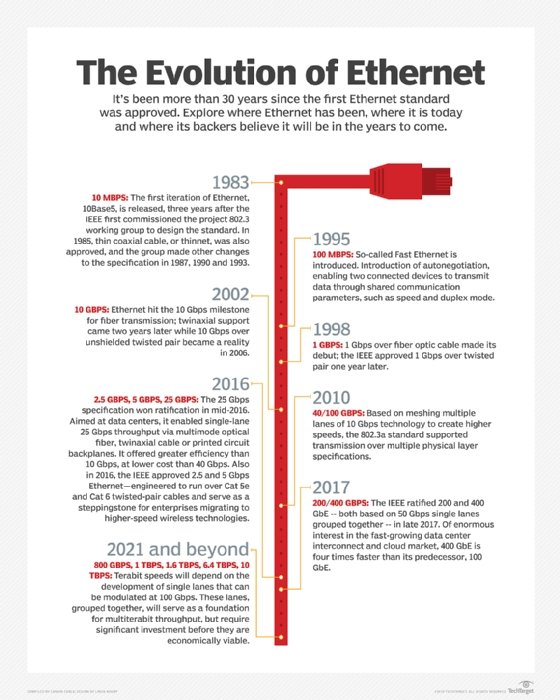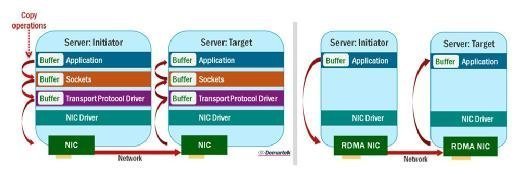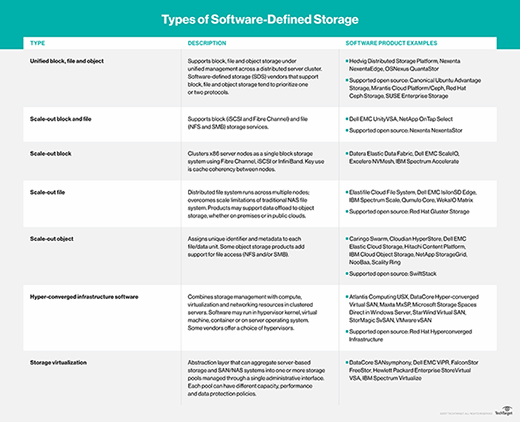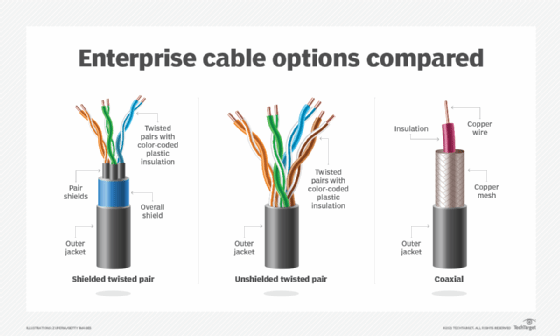100 Gigabit Ethernet (100 GbE)
What is 100 Gigabit Ethernet (100 GbE)?
100 Gigabit Ethernet (100 GbE) is an Ethernet standard that supports data speeds of up to 100 billion bits (gigabits) per second (Gbps). It delivers speed 10 times higher than 10 GbE.
The 100 GbE technology was first defined under the Institute of Electrical and Electronics Engineers (IEEE) 802.3ba-2010 standard. It was then updated periodically under 802.3bg-2011, 802.3bj-2014, 802.3bm-2015, 802.3cd-2018 and other standards.
Since February 2021, the IEEE 802.3cu-2021 standard has defined the physical layers and management parameters for 100 GbE over single-mode fiber.
Evolution of 100 Gigabit Ethernet
Ethernet, now the most widely used local area network technology today, emerged in 1973 at the Xerox Palo Alto Research Center in California. The goal behind its development was to interconnect multiple computer workstations, servers and printers so they could send data to each other.
This was a remarkable achievement in an era that, until then, had been dominated by large, expensive mainframe computers.
Initially, an Ethernet connection could not exceed 2.85 megabits per second (Mbps). In 1980, the Digital Equipment Corporation-Intel-Xerox vendor consortium published the 10 Mbps Ethernet standard, known as the DIX Ethernet standard. So, well into the 1980s, Ethernet networks were limited to maximum speeds of 10 Mbps.
Starting in 1985, numerous IEEE Ethernet standards appeared. However, IEEE does not use Ethernet in the names of these standards, instead calling the technology 802.3 carrier-sense multiple access with collision detection or simply 802.3. Nonetheless, the Ethernet name is still commonly used when referring to the network system described in the 802.3 standard.
In 1995, the 100 Mbps Fast Ethernet system was developed. It included multiple varieties of twisted-pair and fiber optic media systems. Four years later, 1,000 Mbps Ethernet (1 GbE) arrived.
The transition from 1 GbE to 10 GbE took almost seven years. But the move from 10 GbE to 40 GbE required just four years.
Then, as data centers started to move away from 40 GbE and the cost of 100 GbE networking equipment started to fall, 100 GbE networks started to be widely adopted.

Advantages of 100 Gigabit Ethernet
Compared to other Ethernet standards, 100 GbE offers a clear speed advantage. Higher data transfer speeds enable faster access to files within the enterprise network. The standard has the greatest benefit in data center networks and server rooms, however.
As internet traffic increases and data centers host numerous virtual servers and devices, they need to process increasingly complex requests and update information in real time. All of this requires higher data speeds, which 100 GbE can provide.
100 GbE products, such as switches and other networking equipment, are backward-compatible. Existing cabling can be reused by installing new transceivers or modules. This consolidation of cabling simplifies deployment, reduces power and space needs, and keeps costs low.
Several 100 GbE-compatible products are already available, including network interface cards, application-specific integrated circuits, servers, processors and switches. With the new technology, enterprises can reduce the number of nodes and connections deployed to improve performance, lower total cost of ownership and reduce cabling complexity.
In spine networks, 100 GbE helps ease worries about contention ratios and overloading core networks.
The 100 GbE standard also supports organizations looking to adopt Remote Direct Memory Access, RDMA over converged Ethernet and emerging technologies, like non-volatile memory express over fabrics.

Applications of 100 Gigabit Ethernet
The 40 GbE standard is designed for use between servers and the Ethernet switch within an organization. The 100 GbE standard is ideal for long-distance, switch-to-switch transmission.
It is also ideal in mainstream data centers with high-bandwidth and low-latency needs. This is especially true for data centers with traditional workloads but greater virtualization and pooled virtual machines and containers.
100 GbE is also suitable for the following:
- switching, routing and aggregation in data centers;
- internet exchange points;
- service provider peering points;
- high-bandwidth applications, like video on demand; and
- high-performance computing or cloud infrastructure
100 GbE and storage technologies
Software-defined storage decouples storage software from hardware, helping organizations easily and flexibly expand their storage capacity as business needs dictate. But workloads that use technologies like Microsoft Storage Spaces Direct, scale-out storage and hyper-converged infrastructure tend to be storage-intensive, especially when moving large files or continuous data streams.
They put more storage traffic on Internet Protocol-based networks. In that scenario, 100 GbE storage offers greater bandwidth than Fibre Channel, while also lowering costs.

Hardware considerations of 100 GbE
100 GbE supports and integrates with existing Ethernet technologies, interfaces and devices. In the copper medium, it can reach a distance of up to 10 meters. However, when used with single-mode fiber, it can be extended to distances up to 60 miles.
A 100 GbE modulation scheme breaks down 100 Gbps into four polarized schemes or data lanes of 25 Gbps each. First, 100 Gbps is split into two polarized streams. Each stream is then modulated into two 25 Gbps streams.

Before upgrading to 100 GbE, organizations must first ensure that their existing cabling supports these speeds. They must also verify that existing devices are compatible with the standard.
A lack of compatibility could lead to poor clock synchronization between equipment, which could increase latency and packet loss. If devices must be updated, it's important to update their software as well. This includes updates or patches to operating system drivers and firmware.







